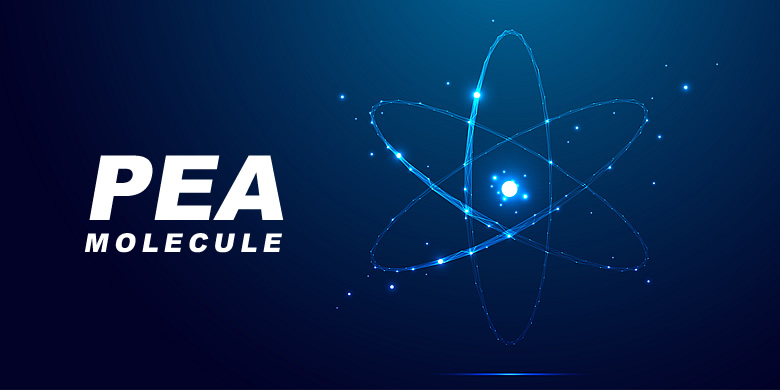The New PEA "Superhero Molecule" Is a Game Changer for Us

Do you struggle with widespread discomfort, brain fog, fatigue, and insomnia? Are you also dealing with sensitivities? Ever wondered what connects all these seemingly unrelated symptoms?
We now have the answer!
Past research identified two key processes behind these symptoms:
- The activation of mast cells, which trigger sensitivities.
- The activation of microglia, the brain's regulating cells.
These two processes often flare up together, causing widespread disruption in the body. But until now, we didn’t fully understand why.
New research is uncovering the connection—and, more importantly, a way to address both. The result? People are feeling dramatically better!
During times of intense stress and distress, our bodies produce a “superhero molecule” called PEA (Palmitoylethanolamide) to help restore balance. The key insight? Both mast cells and microglial cells—major players in inflammation and sensitivity—are responsible for producing PEA. When they struggle to produce enough, they stay in a constant state of activation.
This excess activation triggers all the symptoms I mentioned earlier. It also directly suppresses the hypothalamus, further disrupting the body's equilibrium.
So What's the Solution?
By supplementing with PEA for about two to three months, these overactive cells can begin to calm down, easing symptoms like sensitivities, pain, and fatigue. And the best part? Improvements continue to build over time, helping people feel better and more resilient.
It can give you back your life!
The challenge? PEA is notoriously difficult for the body to absorb. But there's good news—a natural compound called Gammasorb® significantly enhances absorption, making this advanced form of PEA a game-changer.
My recommendation for anyone experiencing these symptoms: Try three bottles of PEA Healthy Inflammation Response, which includes Gammasorb for optimal effectiveness. Full results typically appear within 3 to 12 weeks, with many noticing improvements much sooner.
A fascinating study, along with a short three-minute video by renowned Netherlands pain specialist Prof. Jan Keppel Hesselink, highlights his extensive experience using PEA to treat thousands of patients with severe chronic pain. I highly recommend watching the video—it’s well worth your time!
The research reveals dramatic pain reductions of 60 to 70 percent, with the VAS pain scale dropping from 7.1 to 2.2—an incredible improvement considering that even a 30 percent reduction is considered clinically significant.
Early studies compared 300 mg versus 600 mg of PEA per day, showing that the 600 mg dose was significantly more effective. Since then, Prof. Hesselink has fine-tuned PEA dosing, discovering that higher doses lead to faster and more powerful pain relief.
Prof Jan Keppel Hesselink Recommended PEA Dosing
- Start with 1,200 mg per day for chronic discomfort. Give it a month.
- If needed, increase to 2,400 mg per day for two more months as a fair therapeutic trial.
- In most cases, pain relief begins around the three-week mark with this higher dosing.
- Once you find the dose that works best for you, adjust as needed. If symptoms remain stable for three months, you can likely reduce the dosage while maintaining the benefits.
This is truly exciting new research! If you try this approach, I’d love to hear about your experience. Feel free to email me at FatigueDoc@gmail.com and share your results.
Research Studies
PEA, The Missing Link
Frankly, now that we have a form of PEA that is highly absorbed, everything changes! It makes the dozens of studies meaningful in helping people. So let's look at just a few of them so you can get a sense of why I am so excited.
(Note: Be careful with the terminology. The acronym P-E-A is used for many different molecules. The PEA we are discussing is palmitoylethanolamide.)
PEA Review
Let's begin with a PEA review article published in NCBI (National Library of Medicine), which has 212 study references. It discusses how PEA also works through cannabinoid systems, as well as PPAR pathways. Basically, this means it is working by mechanisms we don't have good medications for. And it works to help so many things. As the review notes, PEA "provide([s] therapeutic benefits in many applications, including immunity, brain health, allergy, pain modulation, joint health, sleep and recovery. PEA's poor oral bioavailability, a major obstacle in early research, has been overcome by advanced delivery systems."
"PEA is thought to be produced as a protective response to cellular injury … effects include… analgesic, anticonvulsant, antimicrobial, … immunomodulatory and neuroprotective activitie. PEA's multi-faceted effects are due to its unique mechanisms of action." It also helps your immune system with viruses, bacteria, and "leaky gut."
"PEA's neuroprotective effects are due to its ability to modify microglia and astrocyte activation." As an added bonus it even improves mood.
PEA also powerfully decreases discomfort by over a dozen different mechanisms, including addressing central sensitization. It supplies an alternative for those who can't get or use low dose naltrexone, and can be synergistic with LDN as well.
Recovery From Exercise
A study published in NCBI showed that PEA significantly improved recovery from exercise, so it may be helpful for post-exertional malaise (PEM).
Sleep Health
Another study on NCBI showed that PEA may improve sleep. "PEA's combined analgesic, anxiolytic and [mood lifting] effects differentiate it from any other sleep aid currently in use and make it an attractive alternative to current treatments."
This study in NCBI showed that it also blocks histamine release by mast cells, which is important. Excess mast cell histamine release in the hypothalamus makes it very difficult to sleep. It also can contribute to discomfort, digestive, and other symptoms.
Brain Health
As an aside, chronic discomfort is associated with more rapid brain aging, according to this study published in Nature. As I've noted in earlier articles, I suspect this is largely through mechanisms such as microglial activation. PEA can markedly help this, and research has shown it to be brain protective. This brain protective quality is discussed in a review with over 100 references. It even enhances neurogenesis (growth of new healthy brain cells), and can help the brain in a large number of other conditions.
This shows PEA to be an important "ounce of prevention" in protecting brain health. The PEA also helped improve cognitive function even in healthy people.
Relief From Discomfort
PEA has been researched in well over 30 studies, with over 6.000 people who had chronic discomfort. As I continue to explore these studies, I am becoming increasingly excited about the importance of this remarkable naturally occurring chemical.
For example, a Netherlands study that was shared with me recently showed that PEA decreased discomfort by a dramatic 60-70% in cases of nerve compression (for instance, lower back problems). If you view the study, you'll find a short video included in it from the researcher. He discusses his experience with PEA in treating thousands of people with chronic pain. The video at the link above is less than three minutes, and well worth watching.
In this video, the researcher shares his experience with thousands of actual severe discomfort patients on optimal dosing and timing. Based on what he describes, I have revised my dosage recommendations to what I note above.
Tired, Achy, Brain Fog, and Can't Sleep?
A number of studies have now shown PEA can improve these symptoms, including this study and this one.
My Recommendation
I recommend getting three bottles of the new PEA Healthy Inflammation Response with Serratiopeptidase, which also includes Gammasorb®.
Follow the dosing guidelines from Prof. Hesselink that I shared earlier. If you have sensitivities, start with a low dose—one-quarter to one capsule per day—to ensure your body tolerates it. Give yourself time to adjust if needed, then gradually increase the dose as your body allows.
In some cases, PEA may be stimulating enough to affect sleep. If this happens, simply lower the dose at first, gradually increasing it over time, and take it in the morning instead.
This is truly exciting new research. If you give it a try, I’d love to hear about your experience. Feel free to email me at FatigueDoc@gmail.com and share your results.

Jacob Teitelbaum, M.D. is one of the most frequently quoted post viral CFS, fibromyalgia, energy, sleep and pain medical authorities in the world. He is the author of 12 books including You Can Heal from Long Covid, the best-selling From Fatigued to Fantastic!, Pain Free 1-2-3, The Complete Guide to Beating Sugar Addiction, Real Cause Real Cure, The Fatigue and Fibromyalgia Solution, and the popular free Smart Phone app Cures A-Z. He is the lead author of eight research studies and three medical textbook chapters on effective treatment for fibromyalgia and chronic fatigue syndrome. Dr. Teitelbaum appears often as a guest on news and talk shows nationwide, including past appearances on Good Morning America, The Dr. Oz Show, Oprah & Friends, CNN, and FoxNewsHealth.
Websites: Vitality101.com | EndFatigue.com
Facebook Support Group: Recovering from Fibromyalgia, Chronic Fatigue, and Long COVID
Facebook Page | Instagram
